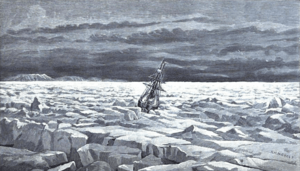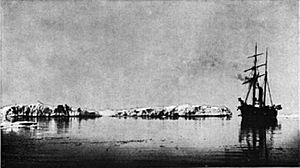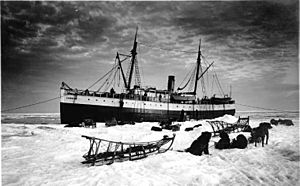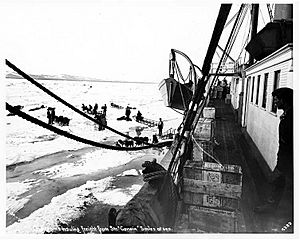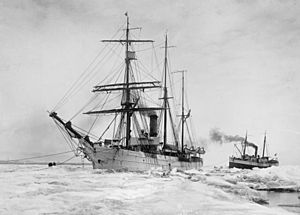USRC Thomas Corwin (1876) facts for kids
class="infobox " style="float: right; clear: right; width: 315px; border-spacing: 2px; text-align: left; font-size: 90%;"
| colspan="2" style="text-align: center; font-size: 90%; line-height: 1.5em;" | 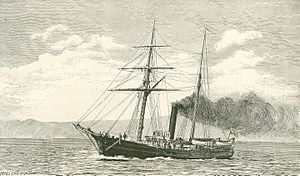
|} The Thomas Corwin was a special ship that served two very different roles, both focused on Alaska and the Bering Sea. First, she was a U.S. government ship that helped enforce laws and provide aid. Later, she became a merchant vessel, carrying goods and people. In 1912, someone wrote that the Corwin had "a more varied and interesting career than any other vessel which plies the Alaskan waters."
The Thomas Corwin was the first government ship to regularly patrol the Bering Sea and the Arctic Ocean. Built in Oregon, she was completed and started her service in San Francisco, which remained her home port. During her 23 years with the government, she searched for lost ships, helped scientists explore islands, was involved in an incident at the Tlingit village of Angoon, stopped illegal alcohol trade, rescued sailors from shipwrecks, explored Alaska, and caught seal poachers. She had many captains, but two famous ones were Calvin L. Hooper and Michael A. Healy. After being sold in 1900, she continued to work in the Bering Sea as a merchant and charter ship.
As a merchant ship, the SS Corwin first supported mining exploration. Later, she was changed to carry passengers. She traveled to coastal towns in Alaska during the shipping season and usually spent winters in Puget Sound. She was often the first ship to reach Nome in the spring and the last to leave in the fall. Her captain for most of her commercial service was Ellsworth Luce West. In 1914, she tried to rescue survivors from the ship Karluk on Wrangel Island and searched for four missing Karluk crew members.
Contents
- Supporting Mining Exploration
- Carrying Passengers and Freight
- Attempted Rescue of the Karluk Survivors
- The End of the Corwin
Building the Thomas Corwin
The Corwin was named after Thomas Corwin, a well-known politician from the mid-1800s who served as the Secretary of the Treasury. She was the second of three government ships to carry this name.
She was built as a steam-powered schooner (a type of sailing ship) by Oregon Iron Works in Albina, near Portland, in 1876. She began her service in San Francisco in 1877. The ship was made of fir wood and held together with copper, galvanized iron, and wooden pegs. Her design was typical for government ships of that time, with a flat deck, a curved bow, and two masts for sails. She also had a pilot house and a funnel in the middle. The engine was powered by a special type of boiler, which was new for these government ships.
Building the Corwin was supposed to finish by February 1876. She was the first government ship built in Oregon, and many people came to watch her launch on August 23, 1876. However, the company that built her went bankrupt, leading to legal problems over unpaid bills. The ship was eventually moved to San Francisco, where she was finished.
The Corwin was a fast ship. She could travel at 12 knots (about 14 miles per hour) using only her sails, 11.5 knots (about 13 miles per hour) with just steam, and 13–14 knots (about 15–16 miles per hour) using both. In 1900, her cruising speed was reported as 9 knots (about 10 miles per hour). She was also armed with guns, and by 1891, she reportedly carried four three-inch rifles and two Gatling guns.
Government Service in Alaska
The Corwin spent her entire government career in the Pacific and Arctic oceans, with San Francisco as her main port. Her first trip to northern waters was in 1877.
Searching for Lost Ships
In 1880 and 1881, under Captain Calvin L. Hooper and Executive Officer Michael Healy, the Corwin searched the Arctic for the lost exploration ship USS Jeannette and two lost whaling ships. To prepare for this, she was covered with extra oak planks to protect her from ice. She also had a special iron attachment for her bow to help break ice. Captain Hooper sent teams by dog sled along the Siberian coast. They learned from the local Chukchi that one whaling ship was lost with no survivors.
During her 1880 trip, Captain Hooper found and mapped coal deposits near Cape Lisburne, Alaska. The crew mined coal from these spots, which became known as the Corwin coal mine. They also visited Alaskan islands and confirmed a terrible famine on St. Lawrence Island that affected many people.
In 1881, the Corwin carried scientists, including famous naturalist John Muir. While searching for the Jeannette, they landed on Herald and Wrangel Island in the Chukchi Sea. In 1882, with Michael Healy as captain, the Corwin picked up the stranded crew of the USS Rodgers, another ship that had burned while searching for the Jeannette.
Other Important Missions
In October 1882, the Corwin was involved in an incident at the Tlingit village of Angoon. Her voyages in 1884 and 1885 included exploring the Kobuk and Noatak rivers in Alaska. She also made the first visit to the newly formed Bogoslof volcano in the Aleutian Islands.
The Corwin was replaced on Arctic patrol by the USRC Bear starting in 1886, partly because the Corwin couldn't carry enough coal for long trips. The Corwin returned to the Bering Sea from 1890 to 1897 to fight fur seal poaching. In 1893, she carried important messages to the U.S. ambassador in Hawaii during a political crisis involving Queen Liliuokalani. Her arrival caused some worry, as people thought it might mean the U.S. would intervene.
Before the 1896 season, the Corwin underwent major repairs. During the Spanish–American War, she served under Navy orders near San Diego. She returned to the Treasury Department in August 1898 and was back in service in Alaska in 1899. The Corwin was officially taken out of service and sold on February 14, 1900. She was replaced by the USRC Manning. Even after being sold, the Corwin continued to be active in the Bering Sea as a merchant and charter ship.
Merchant Career
Supporting Mining Exploration
In 1900, Ellsworth Luce West, a whaling captain, and some investors formed the Corwin Trading Company. They bought the Corwin to develop coal deposits near Cape Lisburne to supply the market in Nome. To make more room for cargo, the ship's living quarters were removed, and a raised deck was added at the back.
Captain West couldn't get a license to carry passengers without more repairs, so the few passengers on board were signed on as crew members. The ship sailed to Nome with mining equipment and other goods. She also helped rescue another ship, the Catherine Sudden, which had hit ice. Later, the Corwin helped a Russian steamer by breaking a channel through the ice so it could reach its destination.
The Corwin was a strong icebreaker. One person described how she would back up and charge the ice, shaking from the impact, until the ice broke apart. After finding that streams near Cape Chaplino were still blocked by ice, the Corwin returned to Nome. In mid-July, she went north to explore for minerals. They found coal deposits, mined about 100 tons, and sold it in Nome.
In 1901, the Corwin was refitted but then stayed tied up for most of the summer because of unpaid bills. Captain West eventually paid the bills and looked for work for the ship.
Carrying Passengers and Freight
By 1902, the Corwin was licensed to carry both passengers and freight. Her cabins were changed to hold 35 first-class passengers and 50 economy-class passengers. She sailed from Seattle in May and spent the summer serving Nome and nearby towns.
Before the 1904 season, the Corwin was greatly modified. A second deck was added, along with a new, strong bow for ice, and new deckhouses. These changes made her look very different. She also got modern features like electric lighting and running water in all rooms. These changes increased her capacity to 100 passengers and about 200 tons of freight. When she sailed in May 1904, some people worried she might be top-heavy, but she reached Nome safely.
The Corwin continued to carry passengers and freight. From 1906 to 1910, she had a contract to deliver mail to towns on Norton Sound and the Seward Peninsula. She was often the first ship to reach Nome in the spring (from 1902–1909, 1913, and 1914) and usually the last to leave in the fall. Her ability to arrive early was thanks to her reinforced bow for ice. In 1908, after reaching Nome during a difficult ice season, the Corwin went back out and cut channels to free three other ships stuck in the ice.
For most of her merchant career, she was owned by the Pacific Coal and Transportation Company. Captain West was her Master from 1902 to 1910, and his wife, Gertrude, worked as the Ship's Clerk. Many of the crew were Eskimo, and the kitchen staff were Chinese. The Corwin had daily fire drills and was equipped with a wireless radio since 1904.
Attempted Rescue of the Karluk Survivors
In 1914, a wealthy businessman named Jafet Lindeberg hired the Corwin to try and rescue the survivors of the ship Karluk from Wrangel Island. She arrived one day after the survivors had already been rescued by another ship. The Corwin then searched for four missing Karluk crew members around Herald Island but found no sign of them. On her way back, the Corwin hit a reef and got stuck. She was freed by throwing off some supplies and with help from the USRC Bear and a crew from the Nome Lifesaving station.
The End of the Corwin
By 1916, the Corwin was mostly owned by Schubach & Hamilton, who sold her to Mexican owners. She caught fire in a drydock (a place where ships are repaired out of the water) in Salina Cruz that same year.
Legacy
Several places in Alaska and Yukon are named after the Corwin. These include Corwin Bluff (near the coal mine), Corwin Rock in the Aleutian Islands, and possibly Cape Corwin on Nunivak Island. The Kivalina lagoon was called Corwin Lagoon for many years. The Corwin Cliffs in the Saint Elias Mountains, Yukon, were also named for the ship in 1890.
A model of the Corwin, built by Captain Thomas Mountain, is part of the collection at the Oregon State Historical Society and was displayed at the Alaska State Museum in 2006.


